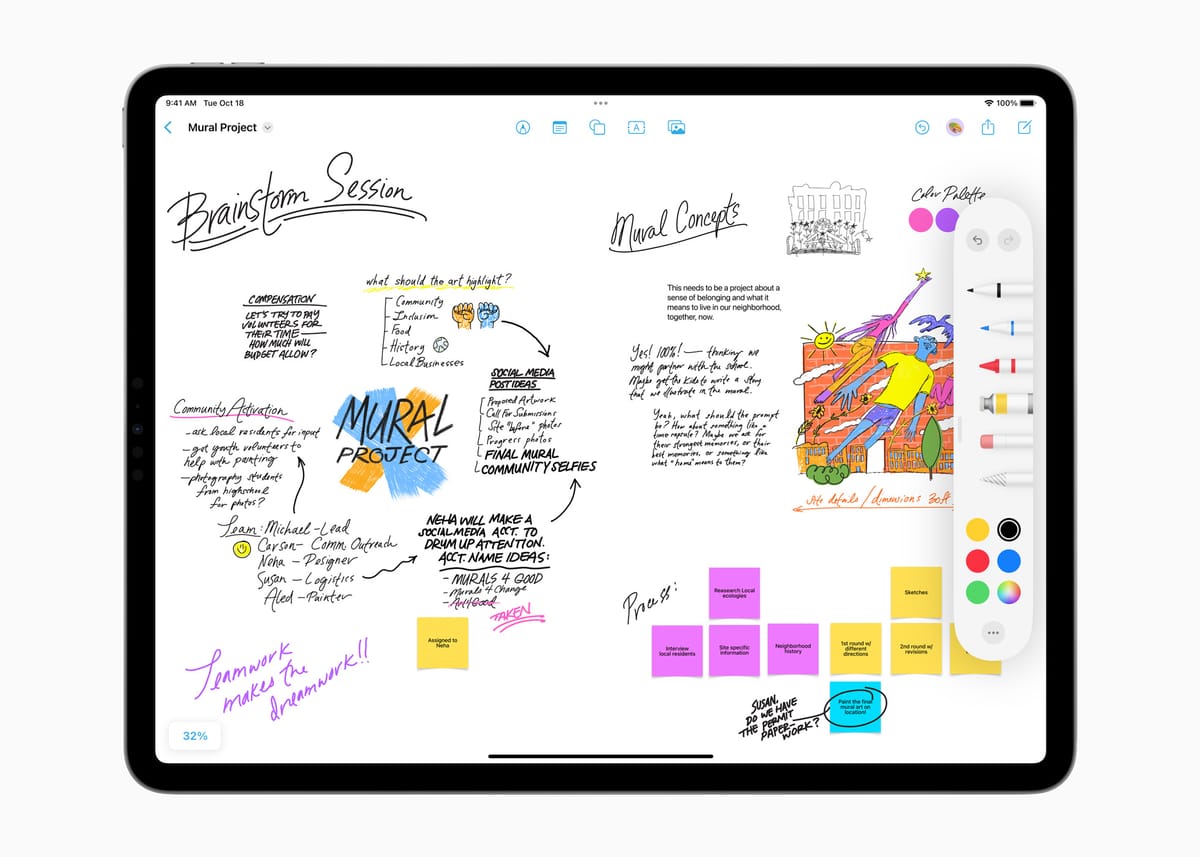Apple Freeform vs Miro
A review of the collaboration canvas tools Apple Freeform and Miro. Both tools allow for brainstorming with virtual post-it notes with others to structure ideas visually. This article compares Apple Freeform with Miro.

During the last couple of years, Corona and lockdowns have changed how we collaborate online and with others with video calling and collaboration tools. I worked remotely for a couple of years before Corona struck, so I was already well-versed in remote work and how to collaborate asynchronously. However, businesses still lag in how to properly work async and remotely, quickly falling back into their hamster wheel of bad habits.
Miro

Tools play a large part in working remotely, ranging from collaboration suites like Office 365 or Google Workspace. These tools enable organizations to collaborate primarily at the communication layer. However, during Corona, what needed to be improved was an excellent way to brainstorm ideas remotely compared to using whiteboards in a meeting room.
During one of the many online meetings during Corona, someone introduced Miro to me, an online brainstorming tool. I am not easily impressed by tools, but Miro is impressive. Miro enables online workshops for idea generation, brainstorming sessions, OKRs, etc.
Miro does a great job organizing thoughts visually. Using post-it notes to structure meetings and cluster ideas together is a game changer. In addition, Miro supports voting on ideas, countdown timers, and visually building a workflow for the workshop. With an expansive library of built-in templates from idea generation to OKRs covers most of the standard workshops. Additionally, community-contributed templates are available, allowing you to find interesting workshop workflows.
Miro checks many boxes for me regarding being able to host an online workshop. However, since Miro allows you to create vast work canvases, it is sometimes easy to get lost on the canvas. Don't worry; Miro also has a "come together" feature that brings all the participants back to the workshop's presenter in such instances. Miro also has extensive integrations library integrations to tools like JIRA, Google, and Microsoft Teams and design tools like FIGMA.
Apple Freeform
When the Apple iOS version 16 finished installing on my phone this week, I quickly glanced over the released notes to discover a new App, Apple Freeform. To my surprise, when I opened the App, it had a very familiar look and feel to the App. It looks very similar to Miro.
Apple Freeform is fresh out of the block, and the first impression is the design is a solid design and native Apple features such as gestures, integration in iMessage & FaceTime, and being able to use the Apple pencil to sketch designs. Considering the App just launched this week, it is already quite feature-rich but still needs to catch up to the mature Miro.
I started doodling around on a blank canvas dragging pictures directly from the finder and my photos to the canvas. I noticed right away that image and object alignment is much easier than Miro. Also, connecting lines between shapes is a masterpiece on its own. However, I quickly hit limitations with Freeflow. For example, rotating images and objects is not available, and creating transparent objects took some poking around to figure out, but I got it working, and no templates are available. Templates will come in the future and help users get started, as starting from a blank canvas takes a lot of effort to set up.
What Apple Freeform lacks in maturity makes up with the integration into the Apple ecosystem. Adding users to the canvas directly via Message is quite an excellent feature; all updates then show in your Messages. Next, users can initiate a FaceTime call now from Freeform.
These features are great but limit their use to other Apple users, which is anti-collaboration in many ways restricting collaboration to only Apple devices. Next, Freeform doesn't cost anything! It is free and can instantly collaborate with 100 other users (Apple users, that is). It's hard to argue with the price, which aims at the personal/start-up space, as Enterprises always like paying for products.
Summary Apple Freeform vs Miro
Product
Miro has a significant headstart regarding the product, integrations, and templates. Miro is also aimed at businesses, whereas Apple, at least for the moment, is aiming for the personal/start-up space.
Freeflow is fresh on the market with its first version. It lags behind Miro. Apple has a track record of not being first to market but taking existing ideas and making them better than everyone else. Let's see if this will be the case also for Freeflow. My wish list for Freeflow is to have templates and more design control over images and objects.
Pricing
Miro is priced very reasonably for all the tiers available. So it won't break the bank for an organization to start using Miro. Freeform is free, and it's hard to argue against that price; it is always hard to say if it will always stay free.
Final thoughts
I will wait to cancel my Miro subscription, as it is a solid product. Miro will stay in my tool pouch for the foreseeable future.
However, I am a huge Apple fan(maybe a fanboy), and I always appreciate the integration of Apple apps across all devices. Also, on the Apple iPad, sketching and drawing using the Pencil enable a different way to brainstorm with a canvas. I expect the experience and feature set to improve continually with future versions.
I have to throw a final curve ball on my last thought. In-person is super valuable, and being able to brainstorm, discuss, and have lunch with your colleagues is extremely valuable and fosters ideas, innovations, and collaborative culture. There is a place for both online and offline workshops, and combining both makes it attractive for the participants and keeps the content and formats fresh.
FAQ Section: Apple Freeform vs. Miro
What are the main differences between Apple Freeform and Miro? Apple Freeform and Miro are both digital collaboration tools, but they differ in features and target audiences. Apple Freeform is designed for seamless integration with Apple's ecosystem, focusing on simplicity and ease of use. Miro, on the other hand, offers more advanced features, including templates, integrations with various third-party tools, and robust collaboration options suitable for larger teams and complex projects.
Which platform is better for real-time collaboration? Miro is generally considered better for real-time collaboration due to its extensive features designed for teamwork, such as voting, commenting, and simultaneous editing. While Apple Freeform also supports real-time collaboration, it is more basic and may be better suited for smaller teams or individual use within the Apple ecosystem.
Can I use Apple Freeform on non-Apple devices? No, Apple Freeform is exclusive to Apple's ecosystem, meaning it is only available on devices such as iPhone, iPad, and Mac. Miro, however, is platform-agnostic and can be accessed on any device with an internet connection, making it more versatile for teams using different operating systems.
How do the pricing models of Apple Freeform and Miro compare? Apple Freeform is free for users within the Apple ecosystem, with no additional costs. Miro offers a freemium model with a basic free tier and multiple paid plans that unlock advanced features, integrations, and expanded team capabilities. This makes Miro scalable for both small teams and large organizations.
Which tool is more suitable for project management? Miro is generally more suitable for project management due to its wide range of templates, project management tools, and integrations with popular project management software like Jira and Asana. Apple Freeform, while useful for brainstorming and simple collaboration, lacks the depth and features needed for comprehensive project management.
Follow me
If you liked this article be sure to Follow Me on Twitter to stay updated!



